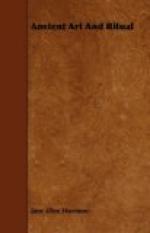Science has given us back something strangely like a World-Soul, and art is beginning to feel she must utter our emotion towards it. Such art is exposed to an inherent and imminent peril. Its very bigness and newness tends to set up fresh and powerful reactions. Unless, in the process of creation, these can be inhibited, the artist will be lost in the reformer, and the play or the novel turn tract. This does not mean that the artist, if he is strong enough, may not be reformer too, only not at the moment of creation.
The art of Mr. Arnold Bennett gets its bigness, its collectivity, in part—from extension over time. Far from seeking after beauty, he almost goes out to embrace ugliness. He does not spare us even dullness, that we may get a sense of the long, waste spaces of life, their dreary reality. We are keenly interested in the loves of hero and heroine, but all the time something much bigger is going on, generation after generation rolls by in ceaseless panorama; it is the life not of Edwin and Hilda, it is the life of the Five Towns. After a vision so big, to come back to the ordinary individualistic love-story is like looking through the wrong end of a telescope.
Art of high quality and calibre is seldom obscure. The great popular writers of the nineteenth century—Dickens, Thackeray, Tennyson, Tolstoy—wrote so that all could understand. A really big artist has something important to say, something vast to show, something that moves him and presses on him; and he will say it simply because he must get it said. He will trick it out with no devices, most of all with no obscurities. It has vexed and torn him enough while it was pushing its way to be born. He has no peace till it is said, and said as clearly as he may. He says it, not consciously for the sake of others, but for himself, to ease him from the burden of big thought. Moreover, art, whose business is to transmit emotion, should need no commentary. Art comes out of theoria, contemplation, steady looking at, but never out of theory. Theory can neither engender nor finally support it. An exhibition of pictures with an explanatory catalogue, scientifically interesting though it may be, stands, in a sense, self-condemned.
We must, however, remember that all art is not of the whole community. There are small groups feeling their own small but still collective emotion, fashioning their own language, obscure sometimes to all but themselves. They are right so to fashion it, but, if they appeal to a wider world, they must strive to speak in the vulgar tongue, understanded of the people.
* * * * *




